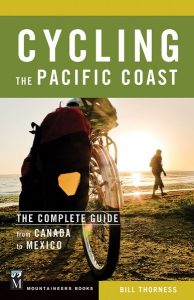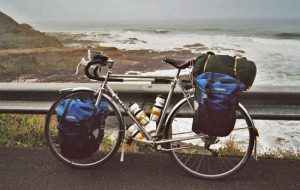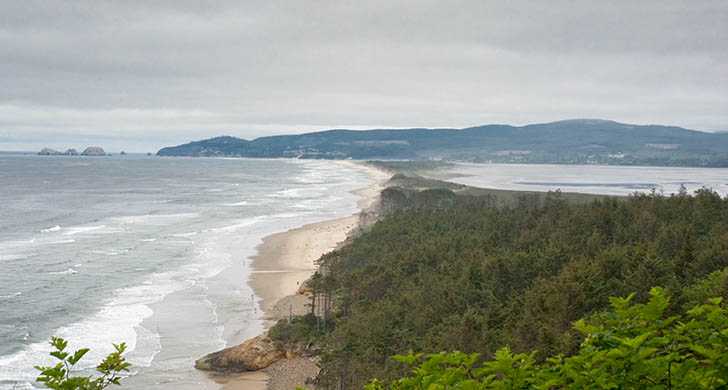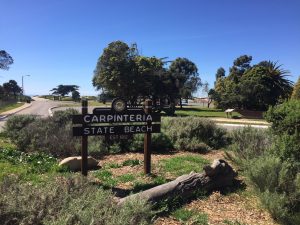Seattle bicycling writer Bill Thorness says riding a bicycle down the Pacific Coast is an epic adventure. I found that opinion hard to dispute after talking to him about his recent guidebook — “Cycling the Pacific Coast: The Complete Guide from Canada to Mexico.”
 Published by Mountaineers Books in partnership with the Adventure Cycling Association, the book presents a 45-day bike trip down the coast. Also included are tantalizing side trips and alternate routes that can extend the experience.
Published by Mountaineers Books in partnership with the Adventure Cycling Association, the book presents a 45-day bike trip down the coast. Also included are tantalizing side trips and alternate routes that can extend the experience.
The book is a great companion guide to the Adventure Cycling mapset for a coastal bike tour. It also can be used as a standalone guide as it contains maps, mileage logs, elevation guides, route descriptions, and camping and lodging suggestions.
I reviewed the book in December (“‘Cycling the Pacific Coast’ is definitive guidebook for West Coast adventure“), but I never published a Q&A with the author presented here. If you’re thinking about a long-distance bike tour, you might want to consider this.
When did you do this, and how long did it take? Did you have to take that detour around the US 1 washout in Big Sur? And if so, how was it?
I started in 2014, right after the second edition of Biking Puget Sound was released, and did my last research ride in fall 2016. Writing commenced in spring 2016 and finished by the end of that year. We worked on the maps and layout issues into the first quarter of 2017.
Yes, that Mud Creek Washout is still a problem! But no, I didn’t encounter it. It was the result of the heavy rains of winter 2016, and the road was closed I think in March. About the same time, they discovered massive damage to the Pfeiffer Canyon Bridge and closed that too. They subsequently tore that down and replaced it. Amazingly, the new bridge is up! They said it would normally take 7 years but they did it in less than one. That bridge is by Big Sur, so you can get there, but the washout means the road south of that is closed. So the detour at Monterey is still required. I recommend Amtrak from Salinas to San Luis Obispo, and skipping that 3-day alternate route. I’ve driven that section and it is not very scenic.
They say the new road being built atop the mudslide will be open by the end of 2018. We’ll see.
Of all the single-day rides, which did you enjoy the most? Which sucked the most (if any did)?
“My favorite ride” is a moving target! I love so many sections for different reasons. But OK, today I will settle on the Cape Lookout to Washburn ride in Oregon, the third and fourth days on the Oregon section. It starts and ends at great campgrounds, each very different. It has a couple of epic climbs, some wooded countryside and lots of coastal cliff riding. Lighthouses. Bridges. Points of interest with evocative names like Cape Foulweather, Otter Crest, Devil’s Punchbowl and Thor’s Well. Great towns like Newport and Yachats. Yep, I’d go back there in a minute. Already planning my trip for next summer, I think.
Which sucked the most? Probably the ones where I got drenched in driving rain and then had to set up my tent and try to keep it dry inside. But it builds character!
I’d also say there are a couple of dry hot days in southern California, such as one that goes through Lompoc just north of Santa Barbara. It can get beastly hot there and it was on one of my trips, where I was cheered on by people driving by in cars because a) they thought I was crazy and b) they figured if they didn’t provide some encouragement I’d probably pass out and melt into the tarmac.
The lesson here is to choose to take a day off if the weather turns against you, whether from rain or heat. Possibly it’ll pass quickly and you can continue in a more enjoyable way.
You mention and route a lot of side trips. Are there any that are don’t-miss?
San Francisco! The official coastal bike route skirts the edge of the city, but it is worth a day or two exploring by bike. Yes, it was famously built on 49 hills, but my city tour uses only one. It’s very bikeable, with bike lanes and off-street trails. And it is chock full of sights and attractions.
I’d also highly recommend the Russian River Side Trip. This is a wine country ride that almost gets you to Napa and Sonoma, but those world-class wine destinations are just a little too difficult to reach from the coast by bike. However, you can bike up the Russian River valley quite easily, find private campgrounds or other lodging along the way, and cycle through three AVAs: Russian River, Anderson Valley and Dry Creek Valley. The town of Healdsburg is a highlight. It’s an easy one-day detour that pays off massively.
Is it necessary to get an Adventure Cycling Pacific Coast map as well? It seems like your book is pretty complete with maps, mileages and descriptions.
I really like the ACA maps. They’re very focused on the route, and have a list of useful contacts for each locality on the back side. But the Mountaineers Books cartography is also very good, and the maps are pretty detailed, as you say. Also my book’s maps are quicker and easier to follow. The ACA maps are a bit tough until you get used to them.
I rode from LA to SF years ago (and I mean like more than 30… bucked the wind the whole time and boy did that suck!) It was after a cross-country ride, and I remember my astonishment at the bike-hike campgrounds. I see you made use of those. Are they still well-maintained?
The hiker-biker campground sites are a godsend! Especially in Oregon, which really does it right. Most of the coastal parks have them, and you don’t have to reserve in advance. In fact, you can’t. It’s usually $5, and in Oregon they throw in free showers! Other places the showers are coin-operated, so spend a buck and take a very efficient 4-minute shower. Oregon’s sites also have electrical outlets and in some places even USB ports, so you can keep your electronics charged. I bet this will be a bigger issue all along the coast with the advent of electric bikes.
Farther south, the hiker-biker sites are less numerous, and sometimes you have to get a regular campsite, which can be $25 or more. That adds up if you’re on a 2-month trip.
Most of the campgrounds are very well maintained, with clean, flat spots for tents, clean bathrooms and pretty safe, with rangers or camp hosts on duty. A few of them have natural attractions that can be challenging – how about waking up with moose outside your tent, or trying to go to sleep with a very odoriferous river channel that dumps stagnant water into the ocean? Yep, it’s out there. But I much prefer the company of other cyclists in the hiker-biker corrals rather than the loneliness of getting a regular site and being by yourself.
 Anything else that you’d like to say to people who are thinking of buying this book?
Anything else that you’d like to say to people who are thinking of buying this book?
If you haven’t done much bike camping, try a short trip or two before heading out on a long haul like the coast. You’ll be better prepared and more comfortable. Also, if you haven’t done long-distance bike travel before, expect that your body will take some time to adjust. Lots of people have a sore bum for the first couple of weeks before the skin toughens up and the muscles get used to repeat performances every day. The way to make that easier is to plan a couple of rest days each week for the first couple of weeks. And take a night off from the campground and sleep in a motel bed once in a while. It’s supposed to be fun, not work, right?




1 comments
I’m looking forward to getting my hands on this guide. I recently relocated to Bremerton WA on the Kitsap Peninsula. Am planning to tour the Kitsap & Olympic peninsulas to prep for the ride down the coast. Thanks for posting the Q&A!